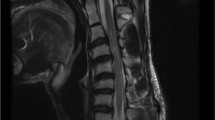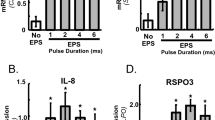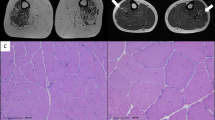Abstract
Study design:
A case report.
Objectives:
This study discusses a case of spinal segmental myoclonus caused by thoracic myelopathy, mimicking hiccup spasms. Spinal myoclonus caused by thoracic myelopathy is extremely rare. It can be misdiagnosed as chronic intractable hiccups due to similar clinical manifestations.
Setting:
Korea University Anam Hospital, Seoul, Republic of Korea.
Methods:
A 42-year-old man presented with a history of involuntary jerky movement of the upper abdominal wall muscles that had been continuing for over 3 years. A neurological examination, brain computed tomography and electroencephalogram did not reveal a cause of the symptoms. Electromyography was performed on the abdominal muscles and the findings revealed were compatible with spinal myoclonus. The spinal myoclonus had started in the abdominal muscles, with a spinal magnetic resonance imaging revealing a disc protrusion compressing the anterior spinal cord.
Results:
The cause of the spinal myoclonus was determined to be spinal myelopathy due to mild T7 disc protrusion. The patient refused surgical or invasive interventions and was conservatively treated with clonazepam. The symptoms were reported to be less frequent following the treatment.
Conclusion:
Compressive myelopathy developed from disc protrusion may cause spinal myoclonus mimicking as hiccup spasms.
Similar content being viewed by others
Log in or create a free account to read this content
Gain free access to this article, as well as selected content from this journal and more on nature.com
or
References
Fahn S, Jankovic J, Hallett M . Principles and Practice of Movement Disorders 2nd edn Elsevier Saunders: Amsterdam. 2011 pp 450–454.
Swanson PD, Luttrell CN, Magladery JW . Myoclonus—a report of 67 cases and review of the literature. Medicine (Baltimore) 1962; 41: 339–356.
Roth G, Magistris MR, Pinelli P, Rilliet B . Cryptogenic hemifacial spasm. A neurophysiological study. Electromyogr Clin Neurophysiol 1990; 30: 361–370.
Campos CR, Limongi JC, Machado FC, Brotto MW . A case of primary spinal myoclonus: clinical presentation and possible mechanisms involved. Arq Neuropsiquiatr 2003; 61: 112–114.
Shivapour E, Teasdall RD . Spinal myoclonus with vacuolar degeneration of anterior horn cells. Arch Neurol 1980; 37: 451–453.
Author information
Authors and Affiliations
Corresponding author
Ethics declarations
Competing interests
The authors declare no conflict of interest.
Rights and permissions
About this article
Cite this article
Lee, CN., Baek, SH., Park, KW. et al. Hiccup-like segmental myoclonus in thoracic compressive myelopathy: a case report. Spinal Cord 52 (Suppl 3), S16–S18 (2014). https://doi.org/10.1038/sc.2014.140
Received:
Revised:
Accepted:
Published:
Issue date:
DOI: https://doi.org/10.1038/sc.2014.140
This article is cited by
-
Acute on chronic cervical myelopathy causing cervical segmental myoclonus in a high-level wheelchair athlete: a case report
Spinal Cord Series and Cases (2021)
-
A case of spinal myoclonus in a patient with elective cesarean section
JA Clinical Reports (2018)



